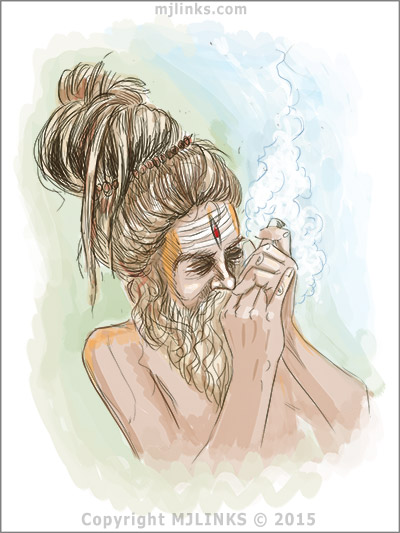The Sadhus of India and their forever Companion: Marijuana.
On the night before the Hindu festival Shivaratri (the anniversary of Lord Shiva’s marriage to Parvati,) if you walked an Indian street that has a temple for Lord Shiva, there’s a strong chance that you’ll see sadhus in different garbs sitting around the temple. Sadhus are people who have renounced the worldly pleasures so that they may seek the knowledge of God and hence, Nirvana. Some sadhus would be wearing black, others saffron, and yet a few others…nothing. These are the devotees of Lord Shiva and though they worship his different avatars, on this night, they all come together to celebrate his wedding.
These Shiva-worshipping sadhus of India are different in more ways than one.
The saffron-clad sadhus with three horizontal white lines on their foreheads are those who have renounced the world and taken up the ascetic way of life. They believe humans have been given their bodies so that they can use them to acquire the knowledge of the divine.
The naked ones or the naga sadhus are the most powerful of them all. They carry weapons and demonstrate incredible feats of the human body. They call themselves Lord Shiva’s warriors. They are perhaps the most revered sadhus of all.
And then there are the aghoris. These sadhus are more feared than revered. The aghoris generally gather around the hindu cremation grounds. They smear the ashes of the dead on their bodies, wear black, drink out of human skulls, and in certain ceremonies, even partake of the human flesh from the dead bodies.
And yet what binds them in their quest of divinity is the hashish that they smoke in their chillums.
In the night, you can see some of these wandering ascetics spreading a thin cotton sheet on the floor of a pavement. Early in the morning, you can see them taking a dip in the cold water of the Ganges or some other holy river. While they travel, the sadhus eat what get by begging. This takes a toll on their health, and it would be foolish to assume that they don’t suffer from joint-pains, backaches, and headaches. But these sadhus try not to visit the doctors – mainly because they don’t attach importance to the body. And yet despite their overt denials to those outside the sadhu-community, many accept that pain can be a terrible distractor. (Source: “Wandering with Sadhus” by Saundra L. Hausner)
Perhaps cannabis – the gift of gods, helps them forget their pain and continue on their quest.
Indian Sadhus & Marijuana
In the evenings, you can see them sitting around the holy fire (the dhuni) passing a chillum of ganja around, talking to each other; or you can find a lone sadhu sitting under a tree, lost in thoughts hidden behind a silvery screen of smoke.
Whether the awe-inspiring feats by the naga sadhus are achieved with some help from marijuana, is something to reflect upon. Does the general sense of wellbeing that envelops one after a puff of ganja, has a part to play in it all?
And those aghoris, the worshippers of Bhairav, the most fearsome manifestation of Lord Shiva, who smear the ashes of the dead on their bodies, and ritualistically consume flesh of the dead – could it be that they are able to overcome their fear of the dead and their revulsion for the carrion, only when they are high on Hashish?
If one talked to a common Indian man on the street today and asked him to opine on the sadhus, in nine cases out of ten, he would tell you that they all are frauds. Perhaps the anti-social elements that find it impossible to exist in society, slither into the fold of sadhus, and give them a bad name. And yet, it’s impossible to deny that for thousands of years, sadhus have lived in the open, braved the heat and the cold, accepted their pain and loneliness, and conquered it all to continue on their chosen paths with one loyal companion by their side. Marijuana.


